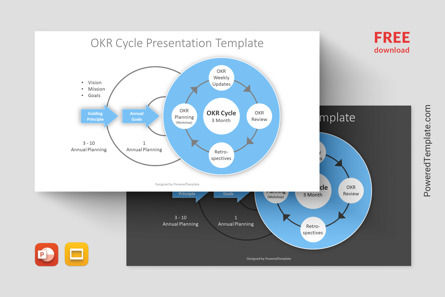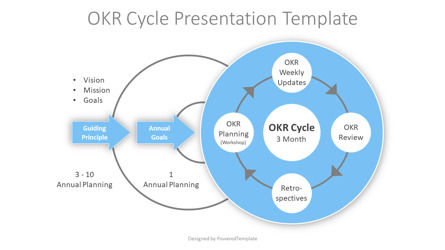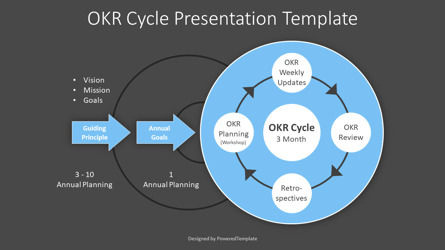Free Google Slides Theme and PowerPoint Template
This free presentation template features a sleek and minimalist design, making it perfect for professional settings. The free template showcases a series of overlapping circles, symbolizing the iterative nature of the OKR (Objectives and Key Results) cycle. Starting from the left, the diagram begins with a larger circle labeled "Guiding Principle" for annual planning spanning 3 to 10 years, followed by a horizontal arrow indicating this period. Inside this circle, there is a smaller circle representing "Annual Goals" for the 1-year planning period. Moving further to the right, the main OKR cycle unfolds with an inner circle divided into four stages or steps: OKR Planning, OKR Weekly Updates, OKR Review, and Retrospectives. Each stage is connected by arrows, illustrating the continuous progression and refinement of objectives and key results.
The OKR (Objectives and Key Results) Cycle is a strategic planning and performance management framework that helps organizations set, communicate, and track goals and results effectively. It is widely used by companies, teams, and individuals to align their efforts, drive focus, and measure progress toward achieving desired outcomes. The OKR Cycle typically consists of several key components:
- 1. Setting Objectives: Objectives are the overarching goals that an organization or team aims to achieve within a specific timeframe. They provide clarity on what needs to be accomplished and serve as the guiding principles for decision-making and resource allocation.
- 2. Defining Key Results: Key Results are measurable outcomes that indicate progress toward achieving objectives. They are specific, measurable, achievable, relevant, and time-bound (SMART), providing concrete benchmarks for success. Key Results help teams understand what success looks like and ensure alignment with the overall objectives.
- 3. Continuous Planning and Iteration: The OKR Cycle emphasizes continuous planning and iteration, typically on a quarterly basis. Teams set OKRs for each quarter, defining objectives and key results that align with organizational priorities and strategic initiatives. Throughout the quarter, teams regularly review progress, adjust priorities as needed, and update OKRs based on changing circumstances.
- 4. Weekly Updates: Weekly updates are an integral part of the OKR Cycle, allowing teams to track progress, identify obstacles, and provide feedback on a regular basis. Teams use these updates to report on their key results, share achievements, discuss challenges, and collaborate on solutions. Weekly updates promote transparency, accountability, and alignment across the organization.
- 5. Quarterly Reviews: At the end of each quarter, teams conduct comprehensive reviews to assess performance against objectives and key results. These reviews provide an opportunity to reflect on successes and failures, identify lessons learned, and celebrate achievements. They also help teams identify areas for improvement and make data-driven decisions to refine strategies and tactics for the next quarter.
- 6. Retrospectives: Retrospectives are reflective sessions held after each quarter to evaluate the OKR process, identify strengths and weaknesses, and implement continuous improvements. Participants share feedback, discuss what worked well and what could be improved, and collaborate on action plans to enhance future performance. Retrospectives foster a culture of learning, adaptability, and continuous improvement within the organization.
Download this OKR (Objectives and Key Results) Cycle free presentation template now and kickstart your journey toward achieving meaningful results with OKRs.






